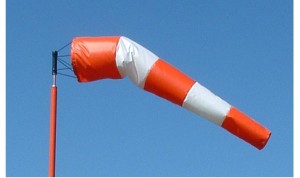I remember riding in the back of the car with my family past the small airport outside of Harbor Springs, Michigan. I was mesmerized by the shapes created by the wind socks that would blow in the breeze providing a sense of velocity and wind direction. To my young eyes, these were animated fingers activitated by the wind to point to the direction of stories. “They’re over there,” they seemed to say.
Still other days, they might have hung limply from their posts as is to say, “Stand by; the story is very near. Come closer; you will see. The story is inside of you.”
Reading through early drafts of student narratives this weekend, I see that these young writers are much like the wind sock. And I see something familiar in their early attempts to harness the wind into something that has velocity (voice) and wind direction (purpose). The students are attempting to tell a story well. I am attempting to move through nanowrimo and to move through it well. We have similar goals and we are driven–seemingly–by the same energy. That breath that moves from “that one time” among the many, to the “once upon a time” that captures a singular moment.
Donalyn Miller suggests that reading is the inhale and writing is the exhale. I like this. It seems to affirm what I believe about the wind sock. It channels the energy of the earth’s breath through a conical form to show us the shape and the form of a gust. A breeze. A draft. A gasp. A guffaw. A breath.
Ask students in the room to tell a story and sit back to stand in the breeze of narrative out in the open. Crosswinds and down bursts fill the room with stories of love and loss, of the capers of pets, of the game-winning shot, the chance meeting with a hero, a recent vacation. The wind socks point to every place in the room, finding a moment against one of the four walls before bouncing back into the room, settling into a corner for an extra moment of development.
And then, we invite them to relate a story on the page. And the socks go limp. They point downward, seemingly lifeless, though in the dangling there is a sense of a wanting to find the beginning of a movement, a voice. A shape. A direction.
Some are frustrated by beginnings. Others find the middle and begin working from there. Still others are found to be pulling at the sock with their finger tips wishing for the inspiration and the expiration that will eventually fill the page. Fill the sock. Have something to show for the breathing wind into a narrative.
We could invite them to feel the rush of a gust onto the page. This is what early writing looks like. Anne Lamott calls them a “down draft” wherein one gets “the writing down.” Those who know the wind know another meaning for the down draft, a force almost as deadly though shorter-lived than the tornado. Here, the page is filled with the debris of detail from a number of could-be narratives. Our work here may be to come in to help sort the fall-out of early energies. There is artifact here of a life having been lived that we can put into the box of a page and a form. We might suggest to the writer, that if we anchor our feet such that we are braced against the early wind’s blowing, we can find our way to the “I” of the storm and that the gale of confusion might be replaced by a breeze of purpose.
And, given multiple attempts to work through a piece of writing, we can begin to see the sock take shape. How it moves gently with every type of breath that might enter into the draft. . .
Here is a gasp.
Here is a guffaw.
Here is a hiccup.
Here is a harkening.
Here is time we cried.
Here is a response to a call.
From gale to gust. . .to down drafts to strong breezes. . .to the in and out of breathing onto the page.
Trusting that the wind sock knows what to do when it is full is part of the trusting of the way our world works by way of the winds. We hold a finger up and we know that the world is doing her work. We point a pen to the page and we join her in a collective breathing.
In and out. In and out.
Experience in. Story out.
When we breathe into a piece of writing, the audience on the other side is filled with the exhalation of our experience. We hope that they might be inspired by what they see.
We can inspire this in our young writers. Let’s take a look at what lands upon the page at the very first. See how it scatters across the page like twenty-five stories might scatter into the air of a room. But, one breath. One voice fills the sock. Gives the story focus.
One sock points back to a memory. One sock blows foward pointing to a goal or dream. One sock honors the sense of essay by blowing and slacking allowing the reader time to process before beging pointed once again. One sock points back to the writer and says, “There is calm here in the quiet of the drafting.”
And from the tarmack, we see twenty-five-to thirty wind socks blowing in the breeze that comes of breathing. Our words onto the page. Our socks filled with words.
When our stories are told well, our wind socks unfold and take sail.
